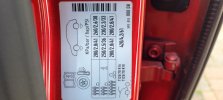Hi all
Hoping for some advice.
I have 2017 Leon FR Mk3 with 225/45/17 tyres but the pressure settings seem contradictory.
Sticker on car shows anywhere from 36 to 41 for fronts with light load although not clear what the thermometer is trying to show against the lower pressure.
Most of the time only me & set of golf clubs in boot!
Car went to Seat recently for some work & came out with pressure increased to 38 PSI all round.
What are other people running?
Cheers
Hoping for some advice.
I have 2017 Leon FR Mk3 with 225/45/17 tyres but the pressure settings seem contradictory.
Sticker on car shows anywhere from 36 to 41 for fronts with light load although not clear what the thermometer is trying to show against the lower pressure.
Most of the time only me & set of golf clubs in boot!
Car went to Seat recently for some work & came out with pressure increased to 38 PSI all round.
What are other people running?
Cheers



